
 |
| Dekatron Glow Transfer Counting Tubes |
For technical data, please refer to the Dekatrons of the World reference. |
|
| ETL GC10B Series | |
Devices included in this entry: | 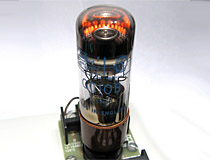 |
| ETL GC12/4B | |
The GC12/4B is a counting tube oddity: a 'dekatron' that is designed to count in base-12 instead of base-10. Base-12 tubes served an important niche function, since the hour of the day is typically measured in 12 or 24 positions, they allowed designers to save an entire tube in any device that measured the time of day. | 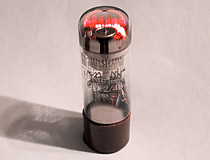 |
| ETL GC10D | |
The GC10D is a single pulse tube with three guides and forty cathode positions. The maximum counting speed is rated at 20kHz, but only when fed with a sine wave input pulse. When driven with a square wave, the maximum speed is only 10kHz. This is one of the most failure-prone dekatrons ever built; the tube's fill gas is over seventy percent helium, and is almost always absent by the time the tube falls into the hands of a collector. | 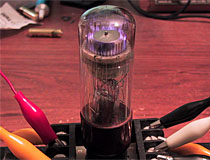 |
| Ericsson GC10/2P | |
Ericsson's sole entry into the miniature counting tube arena, the GC10/2P is a rather unusual device. This tube uses a unique construction style in which cathode and guide rings are constructed from single sheets of folded sheet metal, similar to the method employed by the 'Wales Counter' described above. The cathodes are held in a ceramic sandwich that confines the glow to the top portion of the tube, taken together the entire counting ring is much easier to manufacture than the complex arrays of welded cathode pins seen in many tubes. This tube is a bidirectional double pulse device, with a full 30 cathodes and a neon fill gas. The tube's 1khz counting speed puts it squarely at the bottom of the pack compared to other miniature counting tubes, though to be fair, many of those tubes are much less versatile unidirectional devices. The GC10/2P was a rather short-lived tube, and it is fairly rare as a result. ETL GC10/2P Datasheet (PDF) | 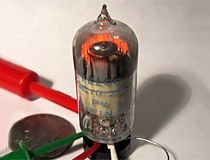 |
| ETL GS12D | |
Devices included in this entry: |  |
| ETL GCA10G & GSA10G | |
Devices included in this entry: The GCA10G is an earlier counting-only variant of Ericcson direct drive technology, and lacks many refinements, such as the finned primary anode and curved secondary anodes. (GCA10G's with late date codes seem to adopt these features.) The GCA10G's lack of selector output cuts the pins on the base down to 18, compare this to the GSA10G, which has a monstrous modified 27 pin base with an extra pin in the center of the socket. Unfortunately the GSA10G and GCA10G were a technology that few actually felt was necessary. Dekatrons already directly indicate their count position, and few felt the substantial additional cost of a Nixie tube was worth it just to give counter operators an Arabic character to stare at. Very few direct drive dekatron part numbers were made and fewer still were used in products. The GSA10G example shown here is actually an Ericsson development sample; the label includes terse warnings about the lack of future supply. | 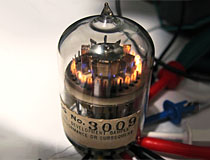 |
| Mullard Z504S & Z505S | |
Devices included inMullard Z504S Series this entry: The Z504S is the standard 4kHz counterpart to the Z505S and is identical in envelope and internal construction other than its more stable neon fill gas | 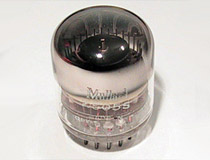 |
| Raytheon 7978 & 8262 | |
Devices included in this entry: | 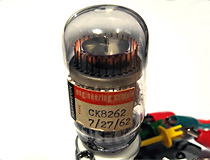 |
| RFT Z562S | |
The Z562S is a German made compact envelope dekatron selector. The Z562 is a neon filled tube very similar to the Sylvania 8353, but has a faster maximum counting speed of 5kHz. The taller than average envelope of the Z562 has a high domed top and heavy shade ring, this tube is a uncommon but visually appealing choice for use in a project. |  |
| RFT Z563C | |
The Z563C is RFT's counting only variant of the Z562S selector tube shown above. This tube has the same envelope and identical stats to the Z562S; a 5kHz maximum counting speed with a neon fill gas. Unlike the Z562S which has a 13 pin base, this tube has a standard 9 pin 'Magnoval' base, and uses commonly available sockets. Four of the pins on the base are stubs and not connected to anything, this tube has only a single output cathode. |  |
| Rodan DK23 | |
Even the Japanese joined the dekatron market with tubes like the DK23, a single-pulse counter with three guides and forty cathode positions. Counting speed is rated at a capable 20 kHz and the fill gas is unknown, but appears to be some sort of Penning mixture consisting of a melange of hydrogen, neon, and other trace gases. Though difficult to find, these tubes are much more robust than ETL's competing single-pulse GC10D, and rarely fail from outgassing. | 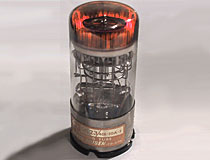 |
| Soviet Anod OG-3 | |
The OG-3 is a single-pulse dekatron with 40 cathodes and an unusual extra output cathode. This dekatron's 20 kHz counting speed is largely due to its helium-hydrogen fill, which gives the tube a purple discharge. The OG3 is currently the most common dekatron in the world, as Soviet surplus floods the international market. This example is a somewhat rarer metal base variant. It should be noted that while it was historically common to blindly refer to all Soviet tubes as being manufactured by 'Sovtek', the example shown here was actually manufactured by Anod. |  |
| Soviet Anod OG-4 Series | |
Devices included in this entry: |  |
| Soviet Melz OG-8 | |
The OG-8 is a very unusual high speed counting tube. The tube is a single guide, unidirectional design with a metal octal base. The tube has 20 bent cathodes under a heavy shade ring, five of which are brought out to individual pins on the base. The tube's rated counting speed is 100Khz and the fill gas in unknown, though it appears to contain a mix of hydrogen and other gases. The OG-8's anode voltage is much higher than other dekatrons: the tube must be driven at over 500 volts to achieve ionization. Normal dekatron driver circuits have trouble spinning the OG-8, and the home experimenter should not expect a stock spinner design to work reliably with this tube. | 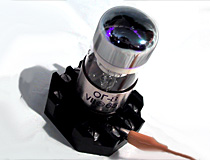 |
| Soviet Anod A-101 Series | |
Devices included in this entry: The A-101 design saw significant improvements in the A-102, which introduced an argon fill, and the A-103, which incorporates some minor internal changes. | 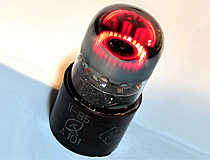 |
| Sylvania 6476A | |
The Sylvania 6476A is an early USA-made neon filled selector. This tube is double guide, with a run-of-the mill 4kHz counting speed and a 12 pin duodecal base. The example shown here has seen heavy use, resulting in a very uneven glow discharge across the cathodes. Sylvania was a prolific manufacturer of dekatrons and the 6476 was one of their most common models. |  |
| Sylvania 6910 | |
Devices included in this entry: | 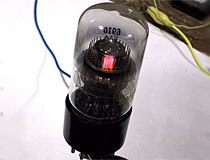 |
| Sylvania 7155 & 6879 | |
Devices included in this entry: | 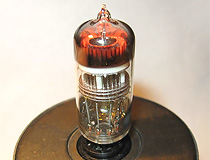 |
| Tesla 11TU7 | |
Tesla's 11TU7 nomotron represents what would seem to be a final logical endpoint for a world that contains both dekatron counting tubes and pixie tubes, a glow transfer counter with actual numeral-shaped discharge indicators like a pixie tube. Despite appearances the numerals at the top of this tube are not actually cut into the shield, but are instead printed on a mica sheet. Holes punched in the shield backlight each numeral when the given cathode is selected. The 11TU7 is a 20khz unidirectional device; the tube's shaped cathodes are hidden below it's metal shroud. The tube is attractively packaged in a stubby blue painted envelope with yellow print and a metal duodecal base. Unfortunately, the example shown here is outgassed, so you will have to use your imagination to picture what an functioning 11TU7 looks like. In operation, the tube produces an orange discharge beneath the currently selected number. | 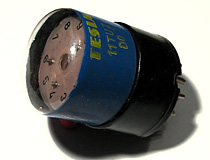 |
| Western Electric 6167 | |
The Western Electric 6167 is a very unusual counting tube. Instead of having pins or bent cathodes like most other dekatrons, the 6167 uses tiny springs for its cathodes. Each spring has a small finger, which exits the top of the spring and hangs over the center of the adjacent cathode. It requires less maintaining voltage to hold a glow discharge within a tube-shaped cathode than upon the surface of rod-shaped cathode, and the 6167 is designed to take full advantage of this phenomenon. During operation the glow will rest in the center of each spring, jumping to the finger only during glow transfer. The 6167's unusual cathode construction makes it a unidirectional tube, with ten output cathodes and ten guide cathodes. The guide cathodes are spit into two groups of five, to allow for base five or base ten counting. The tube actually has 21 cathodes: a single "zeroing" cathode sits outside the counting ring and feeds into the first count position at an angle. The tube can be reset to the zero position by pulling the zeroing cathode to ground without interrupting the counting loop. The tube also has a supplemental anode, which sits between the normal anode and the final output cathode in the counting loop. This anode is used to provide a carry without interrupting the counting loop - the supplemental anode is pulled low as the glow transfer passes by it. It should be noted that even though this tube uses an unusual 16-pin base, it can be used with normal Cinch 13-pin nixie tube sockets due to the cylindrical void located in their center. The 6167 will also fit 20-pin sockets like those used for the MO-10R beam switching tube. | 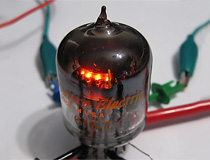 |
| ©2000-2025 Industrial Alchemy. All rights reserved. | Switch to mobile version | Contact | |  |